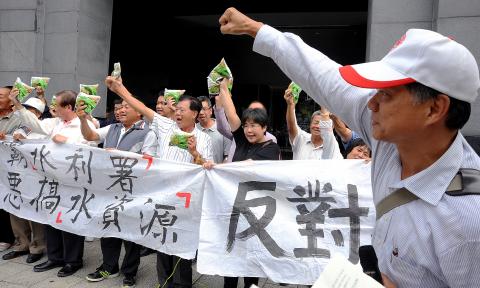Environmentalists and farmers from Pingtung County and Greater Kaohsiung yesterday staged a protest against the Gaoping Great Lakes (高屏大湖) project, which they fear would divert water used for farming and damage local soybean production.
A project of the Water Resources Agency’s (WRA) Southern Region Water Resources Office, it would build five manmade lakes in a nearly 700-hectare area covering many farms at the border of Pingtung County’s Ligang Township (里港) and Greater Kaohsiung’s Meinong District (美濃).
The project was originally part of the Jiyang artificial lake project, which passed an environmental impact assessment in 2002, for cross-border water channeling and to save water during dry seasons.

Photo: Liu Hsin-de, Taipei Times
After severe flooding in the south caused by Typhoon Morakot in August 2009, the project was modified to become part of a southern Taiwan water stabilization project by the WRA. It was further modified into a three-phase project, with the first artificial lake — covering about 200 hectares — being constructed in the first stage.
About a dozen protesting farmers held bags of green soybeans in front of the EPA’s offices yesterday, saying that the project risked damaging their livelihood.
A member of a farmers’ association said that the area produces between 30,000 tonnes and 50,000 tonnes of quality green soybeans for export, which bring in about NT$400 million (US$13.7 million) annually.
More than 10,000 farmers and workers at food processing companies rely on the green soybeans for their living, they said, adding they feared that farmland leased from the state-run Taiwan Sugar Corp would be reclaimed or the construction project would damage the surrounding natural environment.
Frank Yang (楊俊朗), of the civic group Citizen of the Earth, Taiwan, said that the results of the WRA’s evaluation, based on data collected from 2007 to 2010, showed that the level of groundwater in the area was high and building artificial lakes would not only be a waste of arable land, but would also cause damage because of extensive extraction.
The project aims to channel excess water from the Nanhua Reservoir (南化水庫) and the Gaoping River Dam (高屏溪攔河堰), but the only time the two areas have excess water is in summer, Yang said.
Moreover, since the target areas do not suffer from a water shortage during summer, he questioned why the government should spend billions of dollars to construct manmade lakes that would have very limited benefits.
An ad hoc EIA meeting yesterday concluded that the WRA must submit supplementary information to explain the committee’s questions on the project for further discussion in the next meeting.

US climber Alex Honnold is to attempt to scale Taipei 101 without a rope and harness in a live Netflix special on Jan. 24, the streaming platform announced on Wednesday. Accounting for the time difference, the two-hour broadcast of Honnold’s climb, called Skyscraper Live, is to air on Jan. 23 in the US, Netflix said in a statement. Honnold, 40, was the first person ever to free solo climb the 900m El Capitan rock formation in Yosemite National Park — a feat that was recorded and later made into the 2018 documentary film Free Solo. Netflix previewed Skyscraper Live in October, after videos

NUMBERS IMBALANCE: More than 4 million Taiwanese have visited China this year, while only about half a million Chinese have visited here Beijing has yet to respond to Taiwan’s requests for negotiation over matters related to the recovery of cross-strait tourism, the Tourism Administration said yesterday. Taiwan’s tourism authority issued the statement after Chinese-language daily the China Times reported yesterday that the government’s policy of banning group tours to China does not stop Taiwanese from visiting the country. As of October, more than 4.2 million had traveled to China this year, exceeding last year. Beijing estimated the number of Taiwanese tourists in China could reach 4.5 million this year. By contrast, only 500,000 Chinese tourists are expected in Taiwan, the report said. The report

Temperatures are forecast to drop steadily as a continental cold air mass moves across Taiwan, with some areas also likely to see heavy rainfall, the Central Weather Administration (CWA) said. From today through early tomorrow, a cold air mass would keep temperatures low across central and northern Taiwan, and the eastern half of Taiwan proper, with isolated brief showers forecast along Keelung’s north coast, Taipei and New Taipei City’s mountainous areas and eastern Taiwan, it said. Lows of 11°C to 15°C are forecast in central and northern Taiwan, Yilan County, and the outlying Kinmen and Lienchiang (Matsu) counties, and 14°C to 17°C

STEERING FAILURE: The first boat of its class is experiencing teething issues as it readies for acceptance by the navy, according to a recent story about rudder failure The Hai Kun (海鯤), the nation’s first locally built submarine, allegedly suffered a total failure of stern hydraulic systems during the second round of sea acceptance trials on June 26, and sailors were forced to manually operate the X-rudder to turn the submarine and return to port, news Web site Mirror Daily reported yesterday. The report said that tugboats following the Hai Kun assisted the submarine in avoiding collisions with other ships due to the X-rudder malfunctioning. At the time of the report, the submarine had completed its trials and was scheduled to begin diving and surfacing tests in shallow areas. The X-rudder,